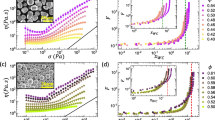Abstract
Biological macromolecules have unique rheological properties that distinguish them from common synthetic polymers. Among these, fibrin has been studied extensively to understand the basic mechanisms of viscoelasticity as well as molecular mechanisms of coagulation disorders. One aspect of fibrin gel rheology that is not observed in most polymeric systems is strain hardening: an increase in shear modulus at strain amplitudes above 10%. Fibrin clots and plasma clots devoid of platelets exhibit shear moduli at strains of approximately 50% that are as much as 20 times the moduli at small strains. The strain hardening of fibrin gels was eliminated by the addition of platelets, which caused a large increase in shear storage modulus in the low strain linear viscoelastic limit. The reduction in strain hardening may result from fibrin strand retraction which occurs when platelets become activated. This interpretation is in agreement with recent theoretical treatments of semi-flexible polymer network viscoelasticity.
Similar content being viewed by others
References
Bale MD, Ferry JD (1988) Strain enhancement of elastic modulus in fine fibrin clots. Thromb Res 52:565–572
Bale MD, Janmey PA, Ferry JD, Lorand L (1984) Kinetics of formation of fibrin oligomers. III. Ligation kinetics concurrent with and subsequent to oligomer assembly. Biopolymers 23:127–138
Doi M, Kuzuu NY (1980) Nonlinear elasticity of rodlike macromolecules in condensed state. J Polym Sci Polym Phys Ed 18:409–419
Ferry J, Morrison P (1947) Preparation and properties of serum and plasma proteins. VIII. The conversion of human fibrinogen to fibrin under various conditions. J Am Chem Soc 69:388–400
Ferry JD (1983) The conversion of fibrinogen to fibrin: events and recollections from 1942 to 1982. Ann NY Acad Sci 408:1–10
Galanakis DK, Lane BP, Simon SR (1987) Albumin modulates lateral assembly of fibrin polymers: evidence of enhanced fine fibril formation and of unique synergism with fibrinogen. Biochem 26:2389–2400
Gittes F, Mickey B, Nettleton J], Howard J (1993) Flexural rigidity of microtubules and actin filaments measured from thermal fluctuations in shape. J Cell Biol 120:923–934
Handen MS (1984) Fibronectin and coagulation factor XIII increases blood platelet adhesion to fibrin. Thromb Res 34:551–556
Hartwig JH, Bokoch GM, Carpenter CL, Janmey PA, Taylor LA, Toker A, Stossel TP (1995) Thrombin receptor ligation and activated Rac uncap actin filament barbed ends through phosphoinositide synthesis in permeabilized human platelets. Cell 82:643–653
Hermans J, McDonagh J (1982) Fibrin: structure and interactions. Sem Thrombos Hemostas 8:11–24
Janmey P, Amis E, Ferry J (1983) Rheology of fibrin clots. VI. Stress relaxation, creep, and differential dynamic modulus of fine clots in large shearing deformations. J Rheol 27:135–153
Janmey PA, Euteneuer U, Traub P; Schliwa M (1991) Viscoelastic properties of vimentin compared with other filamentous biopolymer networks. J Bell Biol 113:155–160
Janmey PA, Hvidt S, Peetermans J, Lamb J, Ferry JD, Stossel TP (1988) Viscoelasticity of F-actin and F-actin/gelsolin complexes. Biochem 27:8218–8227
Jen CJ, McIntire IV (1984) The structural properties and contractile force of a clot. Cell Motil 2:445–455
Kamykowski GW, Mosher DF, Lorand L, Ferry JD (1981) Modification of shear modulus and creep compliance of fibrin clots by fibronectin. Biophys Chem 13:25–28
Käs J, Strey H, Sackmann E (1994) Direct imaging of reptation for semiflexible actin filaments. Nature 368:226–229
Kishino A, Yanagida T (1988) Force measurements by micromanipulation of a single actin filamentby glass needles. Nature 334:74–76
Leterrier JF, Kas J, Hartwig J, Vegners R, Janmey PA (1996) Mechanical effects of neurofilament cross-bridges. Modulation by phosphorylation, lipids, and interactions with F-actin. J Biol Chem 271:15 687–15 694
MacKintosh F, Kas J, Janmey P (1995) Elasticity of semiflexible biopolymer networks. Phys Rev Lett 75:4425–4428
Mosesson M (1990) Fibrin polymerization and its regulatory role in hemostasis. J Lab Clin Med 116:8–17
Mosher DF, Blout ER (1973) Heterogeneity of bovine fibrinogen and fibrin. J Biol Chem 248:6896–6903
Perkins TT, Smith DE, Chu S (1994) Direct observation of tube-like motion of a single polymer chain. Science 264:819–822
Roberts WW, Lorand L, Mockros LF] (1973) Viscoelastic properites of fibrin clots. Biorheol 10:29–42
Ross-Murphy SB, Shatwell KP (1993) Polysaccharide strong and weak gels. Biorheol 30:217–227
Schreiber WE, Schmer G (1984) Application of mechanical impedance measurements to the study of dysfibrinogens. J Lab Clin Med 104:494–500
Shen L, Lorand L (1983)Contribution of fibrin stabilization to clot strength. Supplementation of factor X111-deficient plasma with the purified zymogen. J Clin Invest 71:1336–1341
Torbet J (1986) Fibrin assembly in human plasma and fibrinogen/albumin mixtures. Biochem 25:5309–5314
Wagreich H, Tarlov IM (1945) Studies on the strength of fibrinogen-thrombin clots. Archives of Biochem 7:345–352
Wang LX, Bloomfield VA (1991) Small-angle x-ray scattering of semidilute rodlike DNA solutions-polyelectrolyte behavior. Macromol 24:5791–5795
Yanagida T, Nakase M, Nishiyama K, Oosawa F (1984) Direct observation of motion of single F-actin filaments in the presence of myosin. Nature 307:58–60
Author information
Authors and Affiliations
Corresponding author
Additional information
Dedicated to Prof. John D. Ferry on the occasion of his 85th birthday.
Rights and permissions
About this article
Cite this article
Shah, J.V., Janmey, P.A. Strain hardening of fibrin gels and plasma clots. Rheola Acta 36, 262–268 (1997). https://doi.org/10.1007/BF00366667
Received:
Accepted:
Issue Date:
DOI: https://doi.org/10.1007/BF00366667




